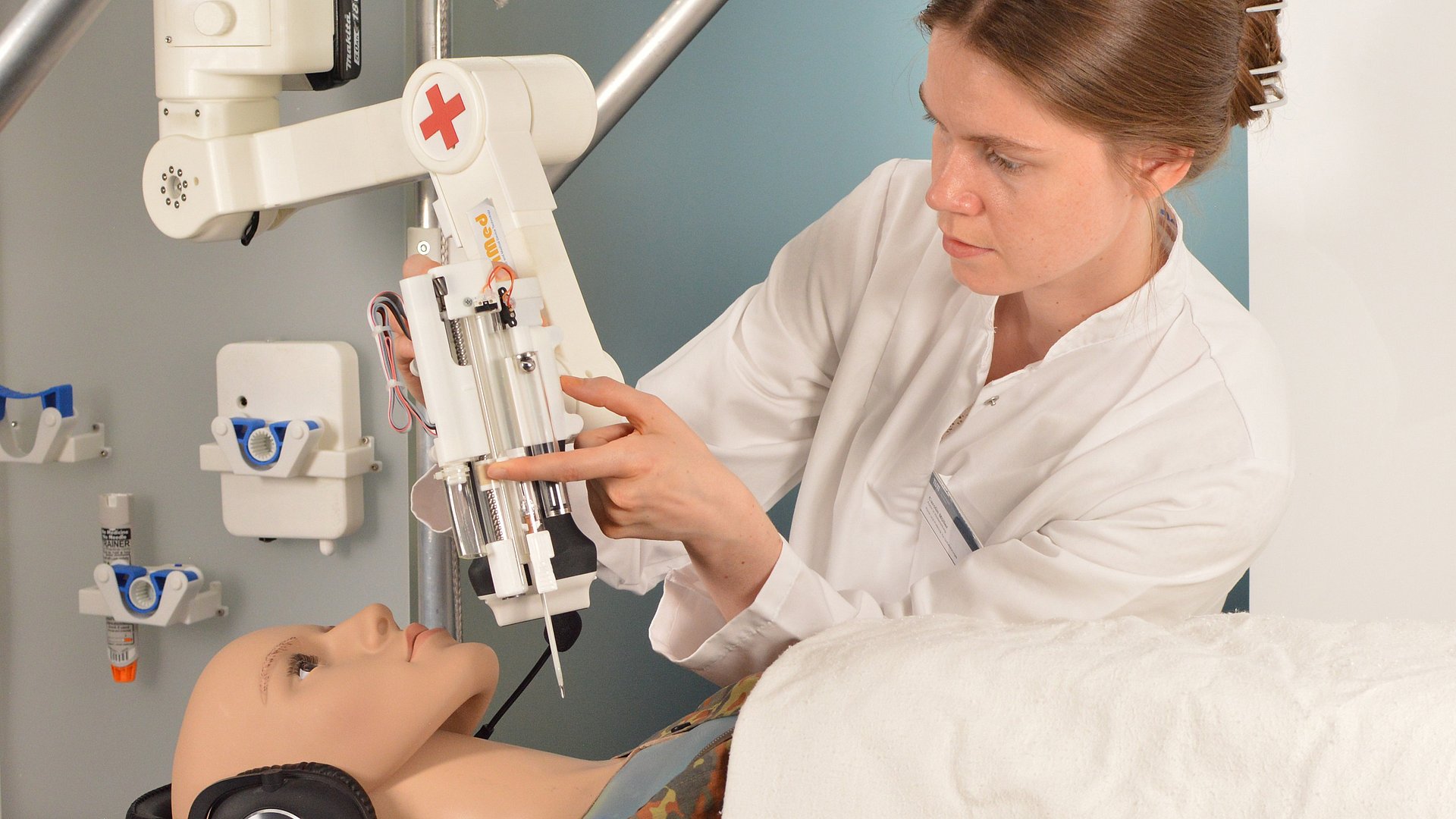Remote relief of tension pneumothorax
Robot treats injured people in flight

In a tension pneumothorax, air accumulates between the pleura and the lungs. This may occur after an injury like a gunshot wound, for example. The air cannot escape and becomes increasingly congested, causing a pressure buildup in the chest, compressing the lungs and ultimately affecting the heart and the large blood vessels. The pulse rises, blood pressure falls and eventually circulation collapses. “This tension pneumothorax is life-threatening,” says Carolin Müller, a researcher at the Clinic and Polyclinic for Trauma Surgery at TUM Hospital. If left untreated, the condition leads to death within minutes. “It is often overlooked, but is easy to treat by inserting a decompression needle into the chest so that the trapped air can escape.”
Robot takes over first aid for injured people
For the future treatment of patients at inaccessible locations, researchers have now developed a robot arm extension – an “end effector” – that combines a decompression needle, resembling the needle-catheter system used for vein access, with an ultrasound device. The needle can be inserted only in the Monaldi or the Bülau positions in the second and fifth intercostal spaces. These points can be accurately located using ultrasound. The system can also diagnose whether a pneumothorax is present.
The new mechanism, developed by Müller in collaboration with researchers from the Chair of Microtechnology and Medical Device Technology (MiMed) at TUM and now being shown for the first time at Automatica, will push the needle and the catheter surrounding it through the skin. The catheter remains in the body while the needle is pulled out, allowing the air to escape. “This buys crucial time to treat patients with a tension pneumothorax, for example, after a chest injury as a result of a traffic accident or a gunshot wound,” explains Prof. Peter Biberthaler, Director of the Clinic and Polyclinic for Trauma Surgery at TUM Hospital.
Combining a flight capsule and telemedicine applications in a single concept
These results are part of the iMEDCAP research project, which the European Defense Fund launched on December 1, 2023, with three years of funding totalling 25 million euros. The focus is on the “development of intelligent military capabilities for monitoring, medical care and evacuation of infectious, injured and contaminated persons”. Under the leadership of the TUM Chair of Flight System Dynamics, 24 organizations from nine countries are involved in the research, including the German Federal Ministry of Defense, institutes of the German Armed Forces, and AVILUS, a startup founded by five TUM doctoral students that is working on the development of medical evacuation drones.
Objectives include the ability to evacuate seriously injured patients from danger zones and crisis areas as quickly as possible by using the remoted-controlled Avilus Grille drone, which is now in the testing stages. The robotic arms attached to the drone will permit in-flight treatment with the participation of a doctor. The arms can use intervention modules to implement emergency medical decisions remotely to save lives.
Further robotic modules under development
The MiMed Rescue Robotics research group, headed by Christoph Parhofer, is developing further robotic modules. They will be capable of independently administering medication through the bone via ‘osseous access’, stopping severe bleeding in the arms and legs by applying a tourniquet, or injecting atropine, for example, in the event of a military emergency involving chemical weapons.
“Our robotic modules can perform some of the tasks that need to be done immediately after an accident,” says MiMed chair holder Prof. Tim Lüth. “It is crucial for the application to be robust and failsafe when every second counts.”
W. Schmidbauer, C. Jänig, E. Vits, T. Gruebl, S. Sauer, N. Weller, K. Kehe, F. Holzapfel, T. Lüth, K. G. Kanz, E. Rittinghaus, P. Biberthaler; Ein neues Rettungskonzept für Schwerstverletzte in militärischen und zivilen Großschadenslagen: DRONEVAC; Notfall & Rettungsmedizin, 7-2023; link.springer.com/article/10.1007/s10049-023-01190-5
- Guided tour for media representatives: Tuesday, 12:30 p.m. to 1:30 p.m.; meeting point: information desk at automatica, Hall B4, Stand 329; accreditation: andreas.schmitz@tum.de
- A module that can be used in the event of a pneumothorax will be on display at Automatica. It was developed as part of the EU project iMEDCAP in collaboration between the Chair of Trauma Surgery at the TUM Klinikum rechts der Isar and the Chair of Microtechnology and Medical Device Technology (MiMed). Click here for all demos from the Automatica trade fair, taking place from June 24–27 in Munich: Messe München; Hall B4, booth 329
- The European Defence Fund: The European Defence Fund (EDF) is a multi-annual framework program that supports competitive and collaborative projects throughout the research and development cycle to achieve a greater impact on European defence capabilities and the industrial landscape. It promotes collaboration between companies and research actors of all sizes and geographical origins in the European Union and Norway in the research and development of advanced and interoperable defense technology and equipment. Further information can be found at eda.europa.eu/what-we-do/EU-defence-initiatives/european-defence-fund-(edf)
- The iMEDCAP project (Development of intelligent military capabilities for monitoring, medical care, and evacuation for contagious, injured, and contaminated personnel, Grant Agreement Number 101121421) began on 1 December 2023 and will run for 36 months. It brings together partners from the armed forces, universities, small and medium-sized enterprises, and industry.
Technical University of Munich
Corporate Communications Center
- Andreas Schmitz
- presse@tum.de
- Teamwebsite
Contacts to this article:
Prof. Peter Biberthaler
Lead Trauma Surgery
TUM Hospital
peter.biberthaler@tum.de
Prof. Tim Lüth
Chair of Micro Technology and Medical Device Technology
Technical University of Munich
tim.lueth@tum.de